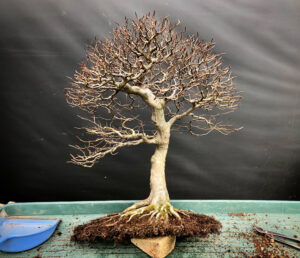
Autumn colours on a Fagus sylvatica/European Beech Bonsai by Harry Harrington
All of us are familiar with the rich and vibrant colours of the leaves on our bonsai in Autumn, but what is the reason for the change in colour before they fall?

Autumn colours on a Parthenocissus quinquefolia / Virginia Creeper bonsai by Harry Harrington
Senescense
The process in a tree that produces Autumn colour and causes leaves to fall is known as Senescense. Senescense is normally initiated when the nutrients produced by the leaves, slows down in the reduced light and temperature levels of Autumn. Shorter days, longer nights and changing light quality all help throw internal switches within the tree itself.
Senescense physically begins by the production of a seal across the base of the leaf. On the leaf side of the seal, the leaf cells weaken and start to become thinner. On the opposite side of the seal, the food transport cells (phloem) become more tenuous.
The cambium cells continue to supply water to the leaves to replace any moisture lost through evaporation as normal. All the time the leaf base cells weaken until it is only the water connections that hold the leaf onto the tree. One by one the leaves lose their hold and fall to the ground. The wound left on the tree is the outward face of the constructed wall established to keep the cold of Winter outside.
Changing Colours
The green colour of leaves comes from chlorophyll. Chlorophyll production in a tree slows with the onset of senescense in Autumn, at the same time, longer nights and cooler temperatures help to break the chlorophyll in a leaf apart.
As the base of the leaf begins to seal, leaf starches (or stored food) is broken apart and is shipped out of the leaf into the tree itself. What chlorophyll remains continues to power the remaining live cells within the leaf itself.
As the green of chlorophyll breaks up and disappears from sight, other pigments remain in the leaf; red, orange and yellow Carotenoids and yellow and tan Xanthophylls.
These pigments were originally made to shield and protect the chlorophyll’s, now the chlorophyll’s have gone, the remaining colours can be seen.
Behind all of these brightly coloured pigments lies the deep brown of the tannins and the light browns of the tree tissues. As the leaf colour eventually fades, it is these browns of the leaf skeleton that are left.
.jpg)
Autumn colours on an English or Field Elm bonsai /Ulmus minor by Harry Harrington
mproving Autumn Colour in Bonsai
When the chlorophyll component of a leaf breaks down quickly and early in Autumn, the remaining coloured pigments are brighter and last longer; Autumn colour is improved. There is no real precise way of promoting this but there are factors that can improve colour;
>Cold early Autumn nights speed up the start of Senescense and increase the strength and length of time that the coloured pigments can be seen.
>Leaves containing lower levels of chlorophyll as a result of midsummer leaf-cutting/ defoliation, or trees that have been fed low doses of nitrogen through the year will take less time for the chlorophyll to exit the leaf and so will display better Autumn colours.




